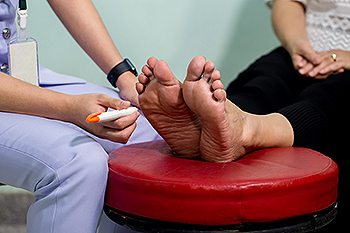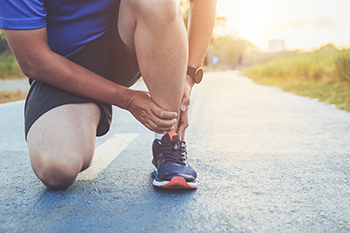Items filtered by date: April 2022
How Diabetes Can Impact the Feet

When you have diabetes, it is important for you to check your feet each day to make sure you do not have cuts or blisters that are not healing. Since about half of those with diabetes have nerve damage, it can cause one to lose feeling in their feet and they may not be aware there is a problem until it worsens and possibly becomes a more serious issue. It is obvious that the first order of business is managing the diabetes through diet, exercise, and necessary medication, but while this takes place it will be necessary to maintain good foot health practices – washing feet regularly, wearing well-fitting foot coverings, and checking for numbness, tingling, and pain. Those who are older and/or have other physical health problems are said to have a greater risk for complications from diabetic foot problems, such as ulcers or other infections. Since amputation can be the result of untreated foot problems in those with diabetes, it is suggested that regular visits to a podiatrist become part of routine foot health maintenance.
Diabetic foot care is important in preventing foot ailments such as ulcers. If you are suffering from diabetes or have any other concerns about your feet, contact the foot specialists from Certified Foot Care. Our doctors can provide the care you need to keep you pain-free and on your feet.
Diabetic Foot Care
Diabetes affects millions of people every year. The condition can damage blood vessels in many parts of the body, especially the feet. Because of this, taking care of your feet is essential if you have diabetes, and having a podiatrist help monitor your foot health is highly recommended.
The Importance of Caring for Your Feet
- Routinely inspect your feet for bruises or sores.
- Wear socks that fit your feet comfortably.
- Wear comfortable shoes that provide adequate support.
Patients with diabetes should have their doctor monitor their blood levels, as blood sugar levels play such a huge role in diabetic care. Monitoring these levels on a regular basis is highly advised.
It is always best to inform your healthcare professional of any concerns you may have regarding your feet, especially for diabetic patients. Early treatment and routine foot examinations are keys to maintaining proper health, especially because severe complications can arise if proper treatment is not applied.
If you have any questions please feel free to contact our offices located in Larchmont and Brooklyn, NY . We offer the newest diagnostic and treatment technologies for all your foot and ankle needs.
Treatment Options for Sweaty Feet
People who have feet that sweat excessively may have a condition that is known as plantar hyperhidrosis. It may be the result of a neurological or endocrine disorder and can be quite uncomfortable. There are several treatment options, and this can depend on the severity of this ailment. Surgery may be a viable option for successfully removing the sweat glands. Patients who are afflicted with this condition often keep an extra pair of shoes and socks close by. It can be professionally and socially disabling, and many patients who have this condition are often embarrassed. If you think you may have hyperhidrosis, it is suggested that you schedule an appointment with a podiatrist who can offer you the correct treatment solutions.
If you are suffering from hyperhidrosis contact the foot specialists of Certified Foot Care. Our doctors can provide the care you need to attend to all of your foot and ankle needs.
Hyperhidrosis of the Feet
Hyperhidrosis is a rare disorder that can cause people to have excessive sweating of their feet. This can usually occur all on its own without rigorous activity involved. People who suffer from hyperhidrosis may also experience sweaty palms.
Although it is said that sweating is a healthy process meant to cool down the body temperature and to maintain a proper internal temperature, hyperhidrosis may prove to be a huge hindrance on a person’s everyday life.
Plantar hyperhidrosis is considered to be the main form of hyperhidrosis. Secondary hyperhidrosis can refer to sweating that occurs in areas other than the feet or hands and armpits. Often this may be a sign of it being related to another medical condition such as menopause, hyperthyroidism and even Parkinson’s disease.
In order to alleviate this condition, it is important to see your doctor so that they may prescribe the necessary medications so that you can begin to live a normal life again. If this is left untreated, it is said that it will persist throughout an individual’s life.
A last resort approach would be surgery, but it is best to speak with your doctor to find out what may be the best treatment for you.
If you have any questions please feel free to contact our offices located in Larchmont and Brooklyn, NY . We offer the newest diagnostic and treatment technologies for all your foot and ankle needs.
Gout Pain Can Be Managed
The Difference Between Strains and Sprains
Anyone who is active in sports or running is probably familiar with foot and ankle pain, the most common of which are strains and sprains. A strain affects a muscle or tendon, which is the tissue that attaches the muscle to a bone. A sprain, however, affects a ligament, which is the band of tissue that actually holds the muscle to the bone. Strains and sprains have similar symptoms, including pain, swelling, bruising, and weakness when you move the injured body part. The main differences between them are how the injury occurs, how serious it is, and how long it may take to recover. A strain, sometimes called a pulled muscle, is more likely to occur when a person doesn’t warm up before the activity, returns to an activity after time off, or continues an activity when their muscles are tired. The muscle or tendon is stretched too far, but will probably heal in a couple of weeks. A sprain is generally the result of twisting a joint, such as an ankle, or landing wrong on the foot from a jump. The ligament is stretched or torn, and is more likely to take between four to six weeks to heal, possibly longer. If you have injured your foot or ankle during an exercise, it is wise to see a podiatrist as soon as possible for a proper diagnosis and options for treatment.
Sports related foot and ankle injuries require proper treatment before players can go back to their regular routines. For more information, contact the foot specialists of Certified Foot Care. Our doctors can provide the care you need to keep you pain-free and on your feet.
Sports Related Foot and Ankle Injuries
Foot and ankle injuries are a common occurrence when it comes to athletes of any sport. While many athletes dismiss the initial aches and pains, the truth is that ignoring potential foot and ankle injuries can lead to serious problems. As athletes continue to place pressure and strain the area further, a mild injury can turn into something as serious as a rupture and may lead to a permanent disability. There are many factors that contribute to sports related foot and ankle injuries, which include failure to warm up properly, not providing support or wearing bad footwear. Common injuries and conditions athletes face, including:
- Plantar Fasciitis
- Plantar Fasciosis
- Achilles Tendinitis
- Achilles Tendon Rupture
- Ankle Sprains
Sports related injuries are commonly treated using the RICE method. This includes rest, applying ice to the injured area, compression and elevating the ankle. More serious sprains and injuries may require surgery, which could include arthroscopic and reconstructive surgery. Rehabilitation and therapy may also be required in order to get any recovering athlete to become fully functional again. Any unusual aches and pains an athlete sustains must be evaluated by a licensed, reputable medical professional.
If you have any questions please feel free to contact our offices located in Larchmont and Brooklyn, NY . We offer the newest diagnostic and treatment technologies for all your foot and ankle needs.
What Kind of Shoes Should I Get if I Am a Fitness Walker?
 With the preponderance of different types of athletic shoes, it can be hard to know which type of shoe is best for you and your needs. Walking shoes are generally designed for comfort rather than performance. They tend to be stiffer and more cushioned than running shoes. Running shoe designers strive to provide the necessary structure and cushioning with the least amount of weight and seaming that might cause blisters. Fitness walkers should look for shoes that are light, have enough cushioning, do not have a great difference between the heel and toe height, have an undercut rather than a flared heel, and that is flexible or bend easily at the forefoot. Running stores that provide expertise in fitting shoes can help with choosing specific brands that might work best for you. However, visiting a podiatrist for shoe recommendations based on your individual needs at various stages of life is recommended for the long-term health and comfort of your feet.
With the preponderance of different types of athletic shoes, it can be hard to know which type of shoe is best for you and your needs. Walking shoes are generally designed for comfort rather than performance. They tend to be stiffer and more cushioned than running shoes. Running shoe designers strive to provide the necessary structure and cushioning with the least amount of weight and seaming that might cause blisters. Fitness walkers should look for shoes that are light, have enough cushioning, do not have a great difference between the heel and toe height, have an undercut rather than a flared heel, and that is flexible or bend easily at the forefoot. Running stores that provide expertise in fitting shoes can help with choosing specific brands that might work best for you. However, visiting a podiatrist for shoe recommendations based on your individual needs at various stages of life is recommended for the long-term health and comfort of your feet.
For more information about walking shoes versus running shoes, consult with the foot specialists from Certified Foot Care. Our doctors can measure your feet to determine what your needs are and help you find an appropriate pair of footwear.
Foot Health: The Differences between Walking & Running Shoes
There are great ways to stay in shape: running and walking are two great exercises to a healthy lifestyle. It is important to know that running shoes and walking shoes are not interchangeable. There is a key difference on how the feet hit the ground when someone is running or walking. This is why one should be aware that a shoe is designed differently for each activity.
You may be asking yourself what the real differences are between walking and running shoes and the answers may shock you.
Differences
Walking doesn’t involve as much stress or impact on the feet as running does. However, this doesn’t mean that you should be any less prepared. When you’re walking, you land on your heels and have your foot roll forward. This rolling motion requires additional support to the feet.
Flexibility – Walking shoes are designed to have soft, flexible soles. This allows the walker to push off easily with each step.
If you have any questions, please feel free to contact our offices located in Larchmont and Brooklyn, NY . We offer the newest diagnostic and treatment technologies for all your foot care needs.



